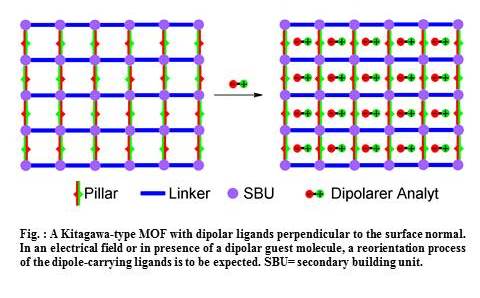Joshua Gies
Metal-organic frameworks (MOFs) have gained significant academic attention since their first mentioning in the 1990s by the group of Omar Yaghi et al.1
MOFs are highly porous materials (inner surface up to 10,000 m2/g)2 and therefore show exceptional gas storage capabilities.
By coordination of organic ligands to a metal ion a two- to three-dimensional polymeric coordination network is formed. The resulting topology of the respective MOF material depends on the selection of the metal-ion (thus the available coordination sites) and the organic linkers (i.e. the nature of coordination chemistry).3
The organic building units allow the manipulation of physical and chemical properties due to the almost unlimited possibilities of organic synthesis. Hence, specific design for the desired application of the respective material is possible. While industrial utilization is still in development, MOF materials which allow usage in gas storage and separation, catalysis as well as in sensing and electrochemical devices have been reported.4
Research:
The main target of my research is the development of novel sensor devices based on MOF materials containing dipolar ligands bound to a surface (surface mounted metal-organic frameworks, SURMOFs). For this purpose MOF materials have to be synthesized and characterized in bulk before they can be deposited on a model surface. Furthermore, the deposition onto the surface has to be optimized to enable the control over the crystallization process in terms of surface coverage and crystal orientation.
The project targets MOFs whose linkers carry dipole moments perpendicular to their molecular axis; the response of these linkers to an electrical field will be investigated, as well as the interaction of the dipolar linkers with guest molecules in the MOF pores. The resulting SURMOFs shall be grown in a fashion, that the dipole moment of the ligands will be parallel to the surface. In presence of a dipolar guest molecule in the pores of the SURMOF, a measurable response to an external electrical field should be generated and allow the usage in sensor devices.

Objectives:
- Synthesis of organic precursors
- Synthesis of bulk-MOF material via solvothermal synthesis methods (reaction under autogenous pressure)4
- SURMOFs buildup
- Characterization of bulk-/SUR-MOFs using among others IRRAS (infrared reflection adsorption spectroscopy), XRD (X-ray diffraction), SEM (scanning electron microscopy)
- Characterization of sensing properties of the SURMOF, among others using dielectric spectroscopy (in cooperation with the research group of Prof. Huth)
This research is part of a DFG priority program (1928 COORNETs) in cooperation with the research groups of Prof. Huth (department of physics, Goethe-Universität Frankfurt) and Prof. Schmid (department of inorganic chemistry, Ruhr-Universität Bochum).
1 Yaghi, O. M.; Li, H.; Davis, C.; Richardson, D.; Groy, T. L. Synthetic Strategies, Structure Patterns, and Emerging Properties in the Chemistry of Modular Porous Solids. Acc. Chem. Res. 1998, 31, 474–484.
2 Hendon, C. H.; Tiana, D.; Walsh, A. Conductive Metal–organic Frameworks and Networks: Fact or Fantasy? Phys. Chem. Chem. Phys. 2012, 14, 13120-13132.
3 Furukawa, H.; Cordova, K. E.; O’Keeffe, M.; Yaghi, O. M. The Chemistry and Applications of Metal-Organic Frameworks. Science 2013, 341, 974–988.
4 Kumar, P.; Vellingiri, K.; Kim, K.-H.; Brown, R. J. C.; Manos, M. J. Modern Progress in Metal-Organic Frameworks and Their Composites for Diverse Applications. Microporous Mesoporous Mater. 2017, 253, 251–265.





 Joshua Gies
Joshua Gies